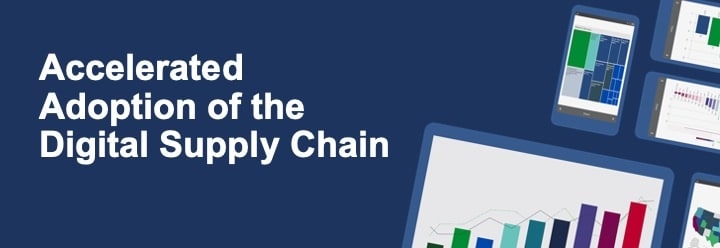Posted by John Delligatti on Tue, 11/24/2020
Earlier this month, I had the pleasure of sitting down with the Institute for Supply Management and Qlik Chief Data Officer, Joe DosSantos to talk about the accelerated adoption of digital supply chain strategies. We discussed transforming organizations to data-driven enterprises, democratizing business intelligence with a connected supply chain approach, and how digital technology is helping organizations better manage the long tail of MRO spend strategically to improve cash flow, site operations, and production. Here are some of the key takeaways
Supply chain integration strategies: the intersection of data, technology and supply chain
Supply chain relies heavily on transparency and visibility from the point of origin to the point of use, and everywhere in between. Data lies at the heart of that visibility – visibility into transactions and inventory. Business intelligence platforms like Qlik are making sure people can use their data to make more informed decisions. Things are changing so rapidly, and people need the ability to make decisions more quickly in order to keep pace. This year has especially brought supply chain to the forefront, because the pandemic disrupted supply chain on a global scale. Supply chains were designed to be agile, and the COVID pandemic proved the need for resiliency in addition to efficiency. So the ability to close the gap between data and insight will allow us to rethink our digital supply chain strategies going forward and build resiliency in the post-pandemic world.
How digital supply chain management can bring us back to basics
Pre-COVID supply chains were focused on digital automation, understanding behaviors and signals, and optimizing those. The post-pandemic world has been, as Joe DosSantos called it, a back-to-basics meat-and-potatoes construct, understanding where they’re going to get their materials from and being able to plan around the demand. A lot of that is focused on PPE in 2020, which has been very unpredictable as the situation changes regularly. So, while the demand signals are no longer predictable, digital technology can help you understand your inventory, giving you the tools to take action and change behaviors to drive different procurement activities to avoid supply chain disruption.
COVID has shifted the focus from growth to business continuity. This means that the way procurement looks at metrics is also changing. A recent study by Boston-based supply management research and advisory firm Ardent Partners shows that 41% of CPOs are pursuing digital transformation. Because the world is so connected, having a tool that allows you to look at the data and understand the country of origin on your maintenance, repair and operations supply is critical. Procurement teams need to use data and digital tools not only to understand who their key suppliers are in each category, but also to identify the back up and tertiary supply sources and where they’re sourcing their materials from. Having these digital tools enables organizations to take what used to be tribal knowledge, unlock the power of data, and democratize it across the enterprise for a more connected supply chain.
Digital Supply Chain Management: Learn. Evaluate. Adapt.
Digital transformation is not just about analytics and BI applications. The focus on automation and leveraging Industry 4.0 technology is still a clear objective, but getting back to basics allows us to take the data, derive insights from it and act upon it – whether manually or automated. The more we’re able to automate, the more strategic we can be in building more resilient supply chains. Most organizations understand their supply chains and have predictive models that help with planning. In the face of a pandemic like COVID, the models need to change on a dime. So, the time to learn, evaluate, and adapt has to be compressed. In order for companies to have successful digital supply chain strategies, they need the capability, the processes, and technology to make those rapid assessments and adjust supply chain planning, production schedules, and overall vision.
This is why data democratization is a strategic focus for SDI. Driving data-based decisions across the business, not just for the data-savvy folks, significantly improves our ability to optimize our customers’ supply chains. For MRO supply chain in particular, there hasn’t been much innovation over the last two decades, and thus very little visibility into the supply chain and limited ability to forecast demand. It’s the nature of the materials, because most organizations run a reactive, break-fix strategy. Thus over 50% of the parts ordered one year will not be ordered the next. It makes predicting consumption patterns difficult. So, the adoption of digital supply chain strategies and the ability to leverage the ecosystem of supply chain and technology partners, like Qlik, helps us innovate and find new ways we can work together to advance the industry in ways that not only improve business performance but also to help keep people safe.
Across the industry, digital transformation is being driven by both consumer expectations and technology. Applying this type of business intelligence is no longer restricted to optimization of the shop floor or the production line. It can be used wherever business systems collect performance data from real-world objects, which means it can help companies reduce maintenance costs, tighten security, improve safety, and prevent waste or poor performance anywhere in the organization. Digital supply chain solutions are bringing together the worlds of data analytics and data integrations. Underpinning that with rich services and deep category expertise, MRO supply chain professionals are able to create that end-to-end data pipeline.
To learn more about how SDI helps our customers build and implement digital supply chain strategies to achieve both operational and financial benefits, contact us today.



